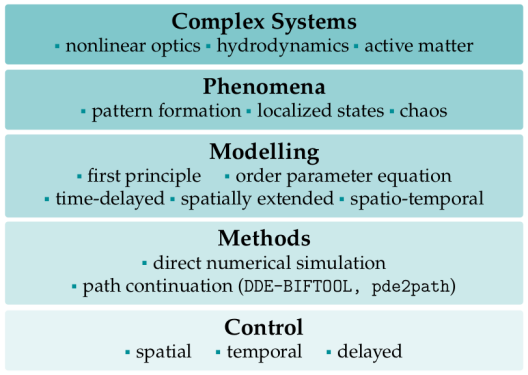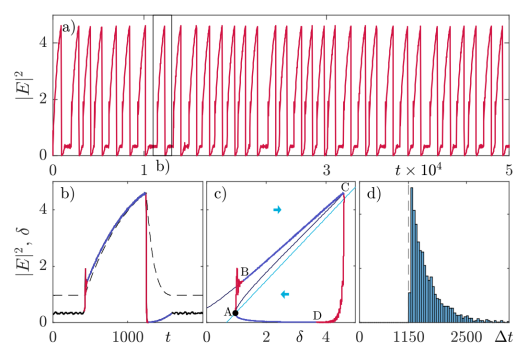The Group

The scientific aim of the research group on Modelling and Control of Complex Systems is to explore universal properties of non-equilibrium dynamical systems with theoretical and numerical methods. Another research line focuses on the control and engineering of the dynamical behavior of spatio-temporal patterns. This includes methods of nonlinear dynamics like bifurcation theory, chaos theory combined with methods of nonlinear optics, statistical physics and the theory of stochastic processes.
Time-delayed modelling
Time-delayed dynamical systems describe a large number of phenomena in nature and exhibit a wealth of dynamical regimes:
dt x = F(x(t), x(t-τ))
They materialize in situations where distant, point-wise, nonlinear nodes exchange information that propagates at a finite speed. In particular, time-delayed systems provide a natural description for many laser systems, e.g., for optical cavities
- Modelling based of on first principles
- Description for electrical field and material properties
- Separation of timescales in long-delay-limit
- Pseudo-space-time representation
- Dynamical instabilities of mode-locked pulses
- Dispersion engineering in time-delayed systems
Selected publications:
Schelte C. et al. (2019). doi: 10.1103/PhysRevLett.123.043902 .
Schelte C. et al. (2020). doi: 10.1103/PhysRevApplied.13.054050 .
Seidel T.G et al. (2022). doi: 10.1103/PhysRevLett.128.083901 .

Excitability

An essential property of neurons allowing them to process and transmit information is excitability. From a dynamical systems perspective, a system is excitable if:
- close to a bifurcation → e.g., ’Canard’ bifurcation
- strong perturbation → large-amplitude excursion
- returns to resting state
We investigate excitability in, e.g.:
- Van der Pol–FitzHugh–Nagumo model: Minimal model to show excitable behavior
- Kerr–Gires–Tournois interferometer
- Thermal effects are slow relative to other time scales → excitability
Selected publications:
Mayer Martins Jonas et al. (2024). doi: 10.1103/PhysRevApplied.22.024050 .

Dynamics of Optical Frequency Combs

- Micro-cavity with nonlinear Kerr medium coupled to external cavity
- Injection detuned with respect to micro-cavity resonance: δ = ωc − ω0
- Model based upon delay algebraic equation
- Temporal localized states in normal (δ > 0) and anomalous (δ < 0) dispersion regimes
δ > 0: Locked domain walls connecting bistable homogeneous solutions
δ < 0: Cavity soliton on stable background as part of pattern state
Selected publications:
Schelte C et al. (2019). doi: 10.1364/OL.44.004925 .
Seidel Thomas et al. (2022). doi: 10.1364/OL.457777 .
Koch E.R. et al. (2022). doi: 10.1364/OL.468236 .

Spatio-Temporal Pattern Formation

- Light bullets: pulses of light that are simultaneously confined in the transverse and propagation directions
- The interplay between optical aberrations and the proximity to the self-imaging condition allows us to control the paraxial diffraction.
- Spatio-temporal mode locking is a promising lasing regime for developing coherent sources for multimode nonlinear photonics
Selected publications:
Bartolo A. et al. (2022). doi: 10.1364/OPTICA.471006 .
Gurevich S.V. et al. (2024). doi: 10.1103/PhysRevResearch.6.013166 .

Computation with Dynamical Systems

- Delay reservoir computing
Time-multiplexing of input inducing virtual nodes
Output: Linear combination of virtual node state - Opto-electronic neurons
Slow-fast dynamics of current and voltage → excitability.
Similar to biological neurons, an opto-electronic circuit can be excitable and thus useful for neuromorphic computing.
Selected publications:
Mayer Martins Jonas et al. (2024). doi: 10.1103/PhysRevApplied.22.024050 .

Control of Mode Locking
Generation of phase independent mode-locked pulses

Passive mode locking
- Gain and absorber sections
- Harmonic solutions with multiple pulses

Active mode locking
- Gain and modulator
- Synchronization
between time-delay
and periodic
modulation

- Because the pulses are not phase-locked, they can behave as independent oscillators
- The phases synchronize in so-called splay states
- The different splay states correspond to shifted frequency combs
Selected publications:
Hausen J. et al. (2020). doi: 10.1364/OL.406136 .
Hessel D. et al. (2021). doi: 10.1364/OL.428182 .
Control of Optical Pulses

We can add elements to the presented systems in order to control properties of the temporal localized states.
Examples for different control strategies include:
- Phase modulation in the KGTI by periodically moving external mirror
- create a potential
- control position of TLSs
- Time-delayed feedback in mode-locked ring cavity
- select harmonic solution
- control relative positions and phases of the pulses
Selected publications:
Seidel T. G. et al. (2022). doi: 10.1063/5.0075449 .
Bartolo A. et al. (2021). doi: 10.1364/OL.414353 .

